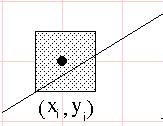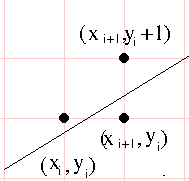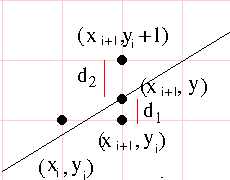- We may later assume that we have a color GetPixel(int x, int y) routine which returns the color value of a pixel set in the frame buffer.
- We also have a way to clear the frame buffer.
- Primitives such as lines, polygons, ...
- These are values in screen coordinates.
- They have attributes such as color, depth, ...
- We will see more of fragments later.
- Fragments might have real coordinates
- But they will be changed to integer values eventually.
- We will draw a lot of lines.
- We need line drawing to be
- Quick
- Accurate.
- Include both endpoints.
- Otherwise our polygons will have holes.
- Brute Force
- m = (y-y1)/(x-x1)
- Becomes y = y1 + m(x-x1)
- There is a problem if x1==x2
- But also problems if m>1
- And some nasty floating point problems.
- Oh ya, and will there be holes?
BruteForce: function() { var x,y; var m; if (this.x1 == this.x2) { for(y =Math.min(this.y1, this.y2); y <= Math.max(this.y1,this.y2) ; y++) { this.PlotPoint(this.x1, y); } } else { m = (this.y1-this.y2)/(this.x1-this.x2) } for(x=this.x1; x<=this.x2; x++) { y = Math.floor(this.y1 + m * (x-this.x1)); this.PlotPoint(x,y); } return; },
- DDA
- Digital Differential Analyzer.
- WLOG assume 0 ≤ |m| ≤ 1
- this means that x is the major axis of change
- Or x changes by 1 each time and y changes by less than 1.
- So no holes.
- Also assume (or force to be true) xstart < xend.
We know that ya = y1 + m(xa - x1) ya+1 = y1 + m(xa+1 - x1) = y1 + m(xa+1 - x1) Because xa+1 = xa + 1 so ya+1-ya = y1 + m(xa+1 - x1) - [y1 + m(xa - x1)] = m - In other words, each time we change x by 1, we change y by m
-
dx = this.x2-this.x1; dy = this.y2-this.y1; m = dy/dx; if (Math.abs(dx) >= Math.abs(dy)) { y = this.y1; for(x=this.x1;x<= this.x2;x++) { this.PlotPoint(x,y); y = y+m; } } - Did we gain anything computationally?
-
//DDA y = y+m; // Brute Force y = Math.floor(this.y1 + m * (x-this.x1)); - Note, we do have to keep y as a float.
- Consider the case where m = 1/4
- We need to accumulate the 1/4 four times for y to change.
- So there is still some nasty floating point math, but far less.
- And actually, any person with any math knowledge would be able to do this optimization.
- What would we have to do for |m| > 1?
- Bresenham's
- Invented in the early 60s at IBM
- By Jack Bresenham
- Again we will assume that xstart < xend
- WLOG assume 0 ≤ |m| ≤ 1
- As we stated before, the center of a pixel is at (x+1/2, y+1/2)
At an arbitrary step i, we have just plotted the point (xi, yi) Which means that the line is within yi+/- 1/2 We need to be able to choose between yi+1 = yi and yi+1
We need to be able to choose between yi+1 = yi and yi+1
 To do this, we compute the distance between the actual y value and
the two pixel based y values.
y = m(xi+1)+b
d1 = y - yi
= m(xi+1)+b -yi
d2 = yi +1 - y
= yi +1 -(m(xi+1)+b)
To do this, we compute the distance between the actual y value and
the two pixel based y values.
y = m(xi+1)+b
d1 = y - yi
= m(xi+1)+b -yi
d2 = yi +1 - y
= yi +1 -(m(xi+1)+b)
 remember xi+1 = xi+1
We form a predictor, Pi for step i
Pi = d1 - d2
if Pi is positive, d1 is larger and the actual
point is closer to (xi+1, yi+1).
if Pi is negative, d2 is larger and the actual
point is closer to ((xi+1, yi),
so d1 - d2 = m(xi+1)+b -yi - [yi +1 -(m(x+1)+b)]
= 2(m(xi + 1) + b) - 2yi -1
= 2m(xi + 1) - 2yi + 2b - 1
= 2mxi - 2yi + 2b + 2m -1
Remember m = Δy/Δx
This has a floating point computation hidden in m so let
pi = Δx Pi
The sign of pi and Pi are the same, which
is what we are interested in.
pi = Δx(d1 - d2)
pi = 2Δyxi - 2Δx yi + Δx(2b +2m -1)
let c = Δx(2b +2m -1)
pi = 2Δyxi - 2Δx yi + c
Notice that this is an integer computation.
so we can compute pi and look at the sign to determine
the value of yi+1
We don't want to recompute pi every
iteration of the loop, it involves two multiples and two adds.
Frequently this is solved by computing the amount pi
changes each step.
pi = 2Δy xi - 2Δx yi + c
pi+1= 2Δy xi+1 - 2Δx yi+1 + c
Δp = pi+1 -pi
= 2Δy xi+1 - 2Δx yi+1 + c -[2Δy xi - 2Δx yi + c]
= 2Δy(xi+1-xi)
- 2Δx (yi+1- yi) +c - c
And we know that xi+1 = xi + 1 so,
Δp= 2Δy(xi+1-xi)
- 2Δx (yi+1- yi) +c - c
= 2Δy - 2Δx (yi+1- yi)
Finally, if y did not change (ie pi < < 0) then
pi+1 = pi
so Δp = 2Δy - 2Δx(yi-yi)
= 2Δy
If y did change pi+1 = pi +1
and Δp = 2Δy - 2Δx(yi + 1 -yi)
= 2Δy - 2Δx
To save computation, we can let
A = 2Δy
B = - 2Δx
And have the following code:
remember xi+1 = xi+1
We form a predictor, Pi for step i
Pi = d1 - d2
if Pi is positive, d1 is larger and the actual
point is closer to (xi+1, yi+1).
if Pi is negative, d2 is larger and the actual
point is closer to ((xi+1, yi),
so d1 - d2 = m(xi+1)+b -yi - [yi +1 -(m(x+1)+b)]
= 2(m(xi + 1) + b) - 2yi -1
= 2m(xi + 1) - 2yi + 2b - 1
= 2mxi - 2yi + 2b + 2m -1
Remember m = Δy/Δx
This has a floating point computation hidden in m so let
pi = Δx Pi
The sign of pi and Pi are the same, which
is what we are interested in.
pi = Δx(d1 - d2)
pi = 2Δyxi - 2Δx yi + Δx(2b +2m -1)
let c = Δx(2b +2m -1)
pi = 2Δyxi - 2Δx yi + c
Notice that this is an integer computation.
so we can compute pi and look at the sign to determine
the value of yi+1
We don't want to recompute pi every
iteration of the loop, it involves two multiples and two adds.
Frequently this is solved by computing the amount pi
changes each step.
pi = 2Δy xi - 2Δx yi + c
pi+1= 2Δy xi+1 - 2Δx yi+1 + c
Δp = pi+1 -pi
= 2Δy xi+1 - 2Δx yi+1 + c -[2Δy xi - 2Δx yi + c]
= 2Δy(xi+1-xi)
- 2Δx (yi+1- yi) +c - c
And we know that xi+1 = xi + 1 so,
Δp= 2Δy(xi+1-xi)
- 2Δx (yi+1- yi) +c - c
= 2Δy - 2Δx (yi+1- yi)
Finally, if y did not change (ie pi < < 0) then
pi+1 = pi
so Δp = 2Δy - 2Δx(yi-yi)
= 2Δy
If y did change pi+1 = pi +1
and Δp = 2Δy - 2Δx(yi + 1 -yi)
= 2Δy - 2Δx
To save computation, we can let
A = 2Δy
B = - 2Δx
And have the following code:
dx = this.x2 - this.x1; dy = this.y2 - this.y1; d = 0; y = this.y1; A = -2*dx; B = 2*dy; for(x = this.x1; x <= this.x2; x++) { this.PlotPoint(x,y); if (d >= 0) { d += B; y++; } d += A; }